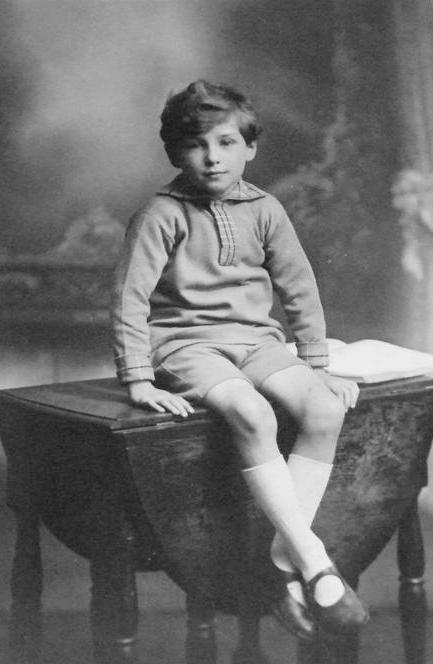
English Strap Shoes: Contruction--Instep Strap Shoes

Figure 1.--Here wse see a boy informally dressed for a portrait. he wears an informal shirt with a rugby front (partial buttoned front) short pants, white socks, and strap shoes. They are the instep style. The style has a formal image in America, but was also worn as a play shoe in England, often done in colors. The portrait is undated, but looks like it was taken about 1920.
|
|
The standard strap shoe came to be an instep strap with a single bar. We note some with multiple bars. An example of a strap shoe with multiple bars were the ones worn by Ernest Barlett in 1904. Another example is an unidentified boy at about the same time. Much more common, however, were the single bar shoes. They are the only ones we see after the early-20th century. They were dres shoes in the 19th century. In the 20th century we see both drss and play shoes. The boy here looks to wearing play strap shoes. There were many variations such as the width of the strap and the area of open space between the strap and closed toe. These shoes were worn by both boys and girls, but after World War II we see them becoming primarily a girls shoes. We see a few pre-school boys wearing them into the 1960s, but mostly boys from wealthy families. They were also worn for formal wear in special occassions like weddings. Boys did mot wear them to school. We begin to see a new construction at the end of the 19th century. It is an ankle strap shoe with a center support post. We first see them as a dress shoe patent leather shoe (1890s). Initially this strap shoe was worn by both boys and girls, but it became seen as a girl's shoes over time. The same construction was adopted as a sandal in the late-1900s decade. The major difference being the leater material and the sole. The sandal had ordinary often brown leather and a more substantial sole. The boys did wear this style to school as a sandal. In gact it became a standard school garment. The sandal version came to be called school sandals.
Standard Instep Strap hoes
The standard strap shoe came to be an instep strap with a single bar. We note some with multiple bars. An example of a strap shoe with multiple bars were the ones worn by Ernest Barlett in 1904. Another example is an unidentified boy at about the same time. Much more common, however, were the single bar shoes. They are the only ones we see after the early-20th century. They were dress shoes in the 19th century. In the 20th century we see both drss and play shoes. The boy here looks to wearing play strap shoes. There were many variations such as the width of the strap and the area of open space between the strap and closed toe. These shoes were worn by both boys and girls, but after World War II we see them becoming primarily a girls shoes. We see a few pre-school boys wearing them into the 1960s, but mostly boys from wealthy families. They were also worn for formal wear in special occassions like weddings. Boys did mot wear them to school.
We begin to see a new construction at the end of the 19th century. It is an ankle strap shoe with a center support post. We first see them as a dress shoe patent leather shoe (1890s). But we see very few until the 20th century. . Initially this strap shoe was worn by both boys and girls, but it became seen as a girl's dress shoe over time, commonly worn throufgout the 20th century. The same construction was adopted as a sandal in the late-1900s decade. The major difference being the leater material and the sole. The sandal had ordinary often brown leather and a more substantial sole. The boys did wear this style to school as a sandal. In gact it became a standard school garment. The sandal version came to be called school sandals. They were very connonly wirn after World War, but declined in popularity in the alte 20th century as snaeakts, acalled trines became commonly worn by boys.
HBC

Navigate the Boys' Historical Clothing Strap Shoe-related Pages:
[Return to the Main strap shoe page]
[White knee socks]
[Sand shoes]
[Pinafores]
[Smocks]
[Kilts]
[Ringlet curls]
[Fauntleroy suits]
[Buster Brown suits]
[Ring bearers]
Navigate the Boys' Historical Clothing Web Site:
[Return to the Main English strap shoe construction page]
[Return to the Main English strap shoe page]
[Return to the Strap shoe country page]
[Introduction]
[Activities]
[Bibliographies]
[Biographies]
[Chronology]
[Clothing styles]
[Countries]
[Contributions]
[Essays]
[FAQs]
[Glossaries]
[Images]
[Links]
[Registration]
[Tools]
[Boys' Clothing Home]
Created: 6:33 PM 4/7/2019
Last updated: 5:10 AM 4/8/2019



